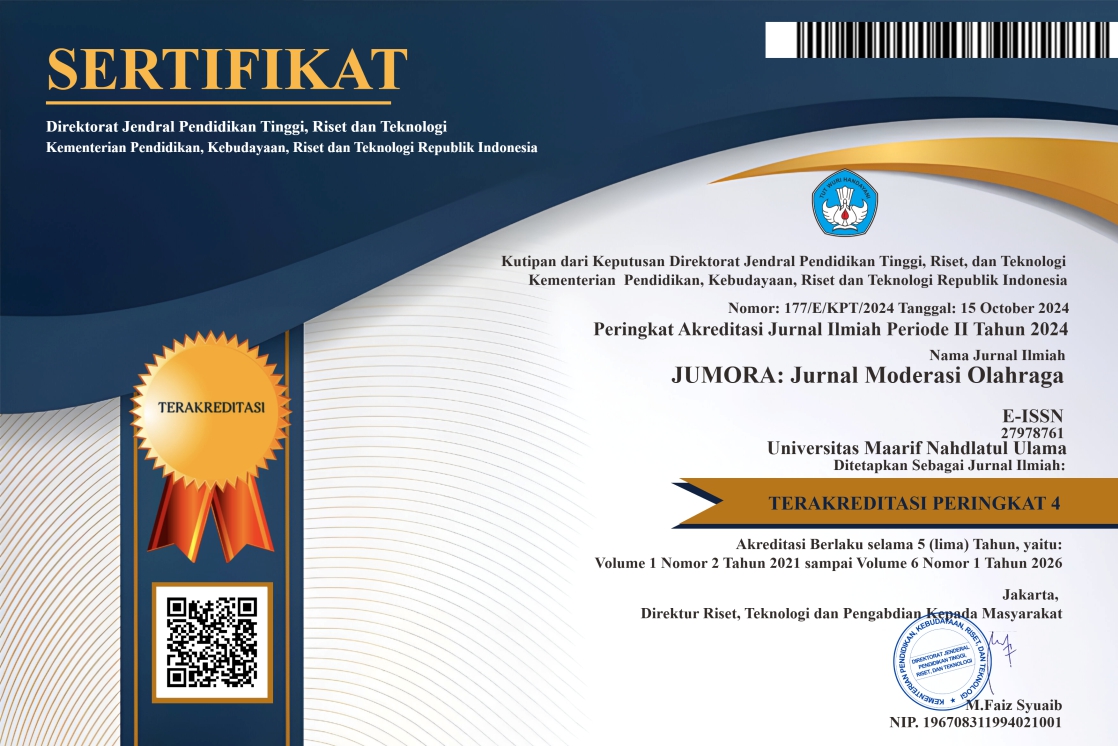The Use of Simplified Learning Materials (SLM) in Physical Education as a Tool in Enhancing Students Learning Experiences
DOI:
https://doi.org/10.53863/mor.v3i1.605Keywords:
JASP Software, Learning performance, Modality, Physical education, Simplified Learning MaterialsAbstract
The pandemic has allowed teachers to apply their innate abilities, such as creativity and innovation, and to impart comprehensive knowledge about physical education with simplified learning materials (SLM) that are centered on the contextual needs of students. The objective of the study is to determine the effect of Simplified Learning Materials (SLM) on students' learning performance in Physical Education. The study specifically aimed to determine the following: (1) evaluate the learning performance of the students in Physical Education before and after using simplified learning materials, and (2) identify the said significant differences between the students' mean scores before and after the intervention. The researchers used a pre-experimental design, specifically the One-Group Pretest-Posttest Design. The study was participated by 52 Grade 8 students in one of the secondary schools in the Philippines. Purposive sampling was used in the study. Data analysis was performed using the JASP software (weighted mean and paired t-test). Data revealed that the Shapiro-Wilk test of normality can be used to determine that the data does not deviate from the assumption of normality with a p-value of 0.305, which is greater than 0.05. According to the descriptive table, the post-test result is higher than the pretest result. The mean difference of -2.538 in the Paired Samples T-Test results is significant, with a p-value of 0.002 for the test. The use of Simplified Learning Materials (SLM) helps grade 8 students perform better on tasks and grasp understanding to the lesson related to physical education. This shows that the intervention has a significant effect on the student’s learning performance in Physical Education. Future researchers can utilize the findings as a foundation to use simplified learning materials (SLM) for further contextualize and address what students need to accomplish.
Keywords: JASP Software, Learning performance, Modality, Physical education, Simplified Learning Materials
References
Acheaw, M. O. (2016). Social media usage and its impact on reading habits: a study of Koforidua Polytechnic students. International Journal of Social Media and Interactive Learning Environments, 4(3), 211. https://doi.org/10.1504/IJSMILE.2016.079493
Antonietti, A., & Giorgetti, M. (2006). Teachers’ beliefs about learning from multimedia. Computers in Human Behavior, 22(2), 267–282. https://doi.org/10.1016/j.chb.2004.06.002
Baccin, C. R. A., Dal Sasso, G. T. M., Paixão, C. A., & De Sousa, P. A. F. (2020). Mobile application as a learning aid for nurses and nursing students to identify and care for stroke patients: Pretest and posttest results. CIN - Computers Informatics Nursing, 38(7), 358–366. https://doi.org/10.1097/CIN.0000000000000623
Barnett, W. S. (2011). Effectiveness of early educational intervention. Science, 333(6045), 975–978. https://doi.org/10.1126/science.1204534
Bozkurt, A., & Sharma, R. C. (2020). 512-Article Text-1131-1-10-20201220. 15(2).
Burhaein, E. (2022). Is There Student Anxiety in Physical Education Learning during the COVID-19 Pandemic in Indonesia? JUMORA: Jurnal Moderasi Olahraga, 2(1), 01–11. https://doi.org/10.53863/mor.v2i1.212
Carag, E. A. (2020). Pedagogical approaches used by teachers in teaching mapeh in the division of Tuguegarao city, Philippines. International Journal of Psychosocial Rehabilitation, 24(8), 678–691. https://doi.org/10.13140/RG.2.2.34224.58882
Culajara, C. J. (2022). Maximizing the Use of Google Sites in Delivering Instruction in Physical Education Classes. 1(2), 79–90. https://doi.org/10.56003/pessr.v1i2.115
Dimitrov, D. M., & Rumrill, P. D. (2003). Pretest-posttest designs and measurement of change. Work, 20(2), 159–165.
Filiz, B., & Konukman, F. (2020). Teaching Strategies for Physical Education during the COVID-19 Pandemic. Https://Doi.Org/10.1080/07303084.2020.1816099, 91(9), 48–50. https://doi.org/10.1080/07303084.2020.1816099
Gaamouri, N., Zouhal, H., Hammami, M., Hackney, A. C., Ben, A., Saeidi, A., El, R., & Ben, O. (2019). Physiology & Behavior E ff ects of polyphenol ( carob ) supplementation on body composition and aerobic capacity in taekwondo athletes. Physiology & Behavior, 205(September 2018), 22–28. https://doi.org/10.1016/j.physbeh.2019.03.003
Hwang, G. J., Chang, S. C., Chen, P. Y., & Chen, X. Y. (2018). Effects of integrating an active learning-promoting mechanism into location-based real-world learning environments on students’ learning performances and behaviors. Educational Technology Research and Development, 66(2), 451–474. https://doi.org/10.1007/s11423-017-9567-5
Klímová, B. F., & Poulová, P. (2022). Designing Web-Based Learning Materials. International Journal of Computers, 16, 56–59. https://doi.org/10.46300/9108.2022.16.11
Sulistiantoro, D., & Budi Setyawan, F. (2021). Physical Education Textbook Study: Techniques and Forms of Assessment of Knowledge and Skills of Middle School Students in Indonesia. JUMORA: Jurnal Moderasi Olahraga, 1(02), 95–104. https://doi.org/10.53863/MOR.V1I02.236
Munir, A., Arief Nur Wahyudi, & Aba Sandi Prayoga. (2021). Pendekatan Model Discovery Learning dalam Keterampilan Teknik Shooting Permainan Bola Basket. Jurnal Pendidikan Modern, 6(2), 68–73. https://doi.org/10.37471/jpm.v6i2.190
Munir, A., Nasrulloh, A., & Nugroho, S. (2022). Definisi, Struktur Dan Penulisan Pada Penelitian Karya Ilmiah Dibidang Ilmu Keolahragaan. Journal Active of Sport, 2, 1–7.
Munir, A., Zahed, A., Qurtubi, A., & Wahyudir, A. N. (2022). Peningkatan Hasil Belajar Passing Sepak Bola Pada Siswa Sekolah Dasar Dengan Metode Sport For Develpoment. Jendela Olahraga, 7(2), 119–129.
N. Acosta, R. A. (2021). Development and validation of grade 10 science learning materials in selected secondary schools in district III, division of Puerto princesa city, Philippines. Journal of Educational Research in Developing Areas, 1(3), 248. https://doi.org/10.47434/jereda.1.3.2020.248
Natividad, E. (2021). Perceived Effectiveness of Self Learning Modules in the Implementation of Modular Distance Learning in the Elementary Level. SSRN Electronic Journal. https://doi.org/10.2139/SSRN.3889429
Nia, T. A., Munir, A., & Suhartini, B. (2022). Modification of Wooden Ball Bullets to Improve the Skillful Motion of Bullet Repellent Games Against Elementary School Students. Edumaspul: Jurnal Pendidikan, 6(2), 2203–2209. https://doi.org/10.33487/edumaspul.v6i2.4556
Prahani, B. K., & Cheng, T.-H. (2020). “New Normal” in Learning and Teaching. Studies in Learning and Teaching, 1(2), 63–65. https://doi.org/10.46627/SILET.V1I2.41
Rausch, J. R., Maxwell, S. E., & Kelley, K. (2010). Analytic Methods for Questions Pertaining to a Randomized Pretest, Posttest, Follow-Up Design. Http://Dx.Doi.Org/10.1207/S15374424JCCP3203_15, 32(3), 467–486. https://doi.org/10.1207/S15374424JCCP3203_15
Reem D. Montesur. (2021). Coping With the Challenges in Teaching Mapeh Subjects Among Non-Specialized Teachers of District 4 in Laguna. EPRA International Journal of Research & Development (IJRD), 7838(June), 191–201. https://doi.org/10.36713/epra7323
Sacramento, M., Ibanezr, G., & MAGAYON, M. V. C. (2021). Technology adaptation of teachers and students under the learning continuity plan: A case of one school in the Philippines. International Journal of Learning and Teaching, 13(4), 204–223. https://doi.org/10.18844/ijlt.v13i4.5594
Tejania, R., Yoila, A., Mvula, Z. H., Kumar, R., & Agarwal, A. (2013). Use of Multimedia as a New Educational Technology Tool: An Overview and Its Future Related papers Forecast ing Some Aspect s of E-Learning Educat ional Syst em Using Dat a Mining Techniques Jyot i Upadhyay Inst ruct ional Design Qualit y: An Evaluat ion o. International Journal of Science and Research, 5, 2319–7064.
Toquero, C. M. D. (2020). Emergency Remote Teaching amid COVID-19: The Turning Point. Asian Journal of Distance Education, 15(1), 185–188.
Ulfa, S. (2017). “Mobile Seamless Learning” Sebagai Model Pembelajaran Masa Depan. JINOTEP (Jurnal Inovasi Dan Teknologi Pembelajaran) Kajian Dan Riset Dalam Teknologi Pembelajaran, 1, 11–19. https://doi.org/10.17977/um031v1i12014p011
Zahed, A., Qurtubi, A., Munir, A., & Wali, C. N. (2022). Efforts to Improve Learning Outcomes of Bullet Repellent Skills in Elementary School Students With Tail Ball Action Modifications. Jurnal Pendidikan EDUMASPUL, 6(2), 2000–2005.
Zientek, L., Nimon, K., & Hammack-Brown, B. (2016). Analyzing data from a pretest-posttest control group design: The importance of statistical assumptions. European Journal of Training and Development, 40(8–9), 638–659. https://doi.org/10.1108/EJTD-08-2015-0066/FULL/XML
Downloads
Published
How to Cite
Issue
Section
License
Copyright (c) 2023 Carla Jobelle Culajara,Anabella Lao

This work is licensed under a Creative Commons Attribution-ShareAlike 4.0 International License.
Authors retain copyright and grant the journal right of first publication with the work simultaneously licensed under a Creative Commons Attribution-ShareAlike 4.0 International License that allows others to share the work with an acknowledgment of the work’s authorship and initial publication in this journal











